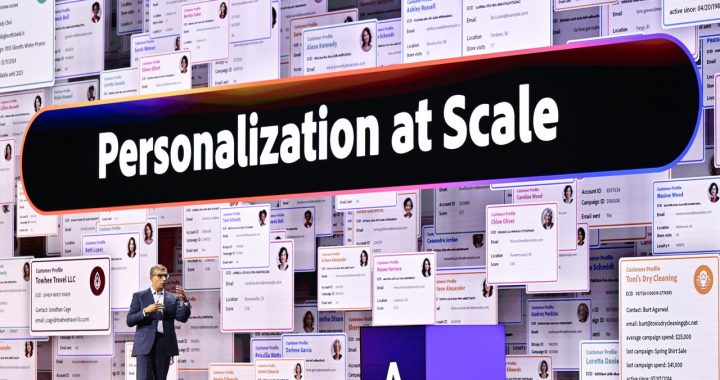Australian banks, supermarkets, telcos and airlines will have access to new Adobe AI technology that will let them run personalised marketing campaigns specific to each individual.
The technology will also be available to the Australian government through Adobe’s involvement with the MyGov portal.
The new capability was among AI-related announcements made at the Adobe Summit in Las Vegas, which concentrated mainly on digital marketing.
The key announcement was Adobe GenStudio, a platform coming in August which combines Adobe technologies, including generative AI, into a single interface for managing marketing campaigns.
Adobe customers can plan campaigns, create content, manage assets, and then automatically run campaigns across social media platforms, websites and email. They can gauge their success of campaigns using Adobe analytics.

Ads are formatted to suit different marketing channels; for example Instagram and TikTok. Generative AI can redesign marketing images to suit the demographics of a targeted person – their age, country and cultural background.
Speaking with The Australian, Adobe principal digital strategist APAC John Mackenney said customers included the big four Australian banks, Woolworths and Coles, Qantas and Virgin Australia, Telstra and Optus, and MyGov.
Mr Mackenney expects opportunities for banks to ramp up their targeted marketing around home loans and wealth management.
“Can we identify based on their behaviour or different elements that they might have money that they need to invest so we can connect them with savings accounts?” he said.
Health is an area where Mr Mackenney expects growth potential in Australia. Pfizer, one of its major US customers, presented at the conference.
Adobe in future could build an AI tool which offers preventative health advice subject to formal medical approval, he said.
Adobe’s marketing tools have given it a potential broader corporate client base beyond the creative industries and beyond rivals such as Australian multibillion-dollar success Canva, which this week acquired Affinity.
But this marketing segment is a long way from being Adobe’s most lucrative. Last year’s combined segment revenue and subscriptions was $US9.22bn while its traditional digital media and creative cloud revenue was $US25.7bn.
How Adobe’s digital marketing tools find brands’ customers and develops ads directly appealing to them, such as a GenX customer of a particular ethnic origin – is an interesting question.
Head of product marketing Ryan Fleisch said Adobe would help brands segment their customer audiences and they could test marketing campaigns on each. But the aim was ultra personalisation. “We want to help brands move past just a very wide aggregate to more truly personalisation,” he said.
The ability of brands to collect data has been blunted by the demise of browser third-party cookies. Google is due to join Firefox and Safari this year by banning them.
Adobe customers already have access to historical data from its customer data platform and this year Adobe is letting brands share data on common customers, when customers consent.
An airline and credit card firm might collaborate to individually target customers with holiday destination offers based on their past travels and spending locations.
Adobe Firefly, the company’s generative machine learning model, underpins this AI capability and is being integrated into all products.
The vice-president of generative AI and Sensei, Alexandru Costin, said Adobe had built three base generative AI models that were trained on images, vector content and designs.
Building and modifying images using text was coming and using text to create video content would be available as samples by year’s end.
Mr Costin told The Australian that Adobe was considering a tool which would output marketing videos automatically translated into dozens of languages with the correct lip synchronisation. Gen AI would soon create 3D images.
In future, the company’s generative AI-based content could move beyond today’s digital devices and take the form of holographic 3D representations displayed on VR/AR glasses such as Apple Vision Pro.
Chris Griffith attended Adobe Summit in Las Vegas courtesy of Adobe. Published in The Australian newspaper, May 3, 2024.
